National Education Policy 2020 - A Comprehensive Analysis
July 31, 2020Introduction: Paragraph 4
Education thus, must move towards less content, and more towards learning about how to think critically and solve problems, how to be creative and multidisciplinary, and how to innovate, adapt, and absorb new material in novel and changing fields.
The Ministry of Human Resources and Development, hereafter to be rightly and more appropriately called the Ministry of Education released the new National Education Policy (NEP 2020) with major reforms. The last major change happened 34 years back. So, this is a huge event and one that educators like me have been rooting for a long time.
I opened the NEP 2020 document with extreme skepticism, ready to write scathing notes on the side. I never thought that for the most part of the document I would be nodding my head in complete agreement.
The most wonderful thing about this document is its acceptance of the problem with the current system. A problem recognized is a problem mostly solved. More remarkably, the policy doesn’t hand wave it away as a small problem; instead gives it a fully qualified weight: “A learning crisis!” and promises to throw everything at it.
Section 2.7
Due to the scale of the current learning crisis, all viable methods will be explored to support the teachers in mission of attaining universal foundational literacy and numeracy.
My dissection of the status quo is a good opener to this article as it enumerates my thoughts on what’s ailing the current education system. An education policy released after 34 years promising reforms must be carefully analyzed:
- Does the policy acknowledge the problems with the current system?
- Does it offer guidelines, improvements and solutions for those problems?
- Does it ignore any known major problems and for what reason?
- Does it introduce any new problems of its own?
- What does the policy mean to its citizens?
This article will dig deep to find answers to each of these questions.
Overview
Introduction: Paragraph 7
It is based on the principle that education must develop not only cognitive capacities - both the ‘foundational capacities’ of literacy and numeracy and ‘higher-order’ cognitive capacities, such as critical thinking and problem solving – but also social, ethical, and emotional capacities and dispositions.
This section charts the course for the rest of the article by outlining the answers to the above questions. Rest of the article will dig into each of the points in this section to provide evidence, commentary, illustrations and analysis from the perspective of an educator, educational researcher and reformer.
Not Lipstick on a pig
Introduction: Paragraph 5
The gap between the current state of learning outcomes and what is required must be bridged through undertaking major reforms that bring the highest quality, equity, and integrity into the system, from early childhood care and education through higher education.
NEP 2020 is not an ornamental or incremental improvement to status-quo. It is a comprehensive reform with substantial improvements and an ambitious vision.
Not a boring government memo
Section 4.36
The current nature of secondary school exams, including Board exams and entrance exams - and the resulting coaching culture of today - are doing much harm, especially at the secondary school level, replacing valuable time for true learning with excessive exam coaching and preparation.
NEP 2020 is full of passion and major portions of the document warm the heart of an educator like me. It is ruthless in its criticism of the status-quo and decisive in its sense of urgency towards improving it.
Addresses most important problems
Introduction: Paragraph 6
The aim must be for India to have an education system by 2040 that is second to none, with equitable access to the highest-quality education for all learners regardless of social or economic background
The NEP categorically and unapologetically calls out and provides solutions for the most important problems plaguing Indian education. I will highlight how the NEP addresses the following problems in the upcoming sections.
1. Pedagogy & Assessments
The NEP deems that the current pedagogy & assessment structure is not just ineffective, but actively harmful.
- The current pedagogy doesn’t offer any alternatives for rote-learning.
- The assessment structure mandates that students learn by rote to score higher.
- High stakes assessments are the norm. You score better marks or lose a year or worse.
- Extremely harmful “coaching culture” is encouraged to offset the risks.
- Perpetrates the toxic we are in a race mindset of parents and children
- Fails to cultivate student ownership in curriculum and learning
- Expresses disdain towards arts & humanities
- Establishes learning silos of distinct subjects without any crossover
- Offers no real world context or practical perspectives
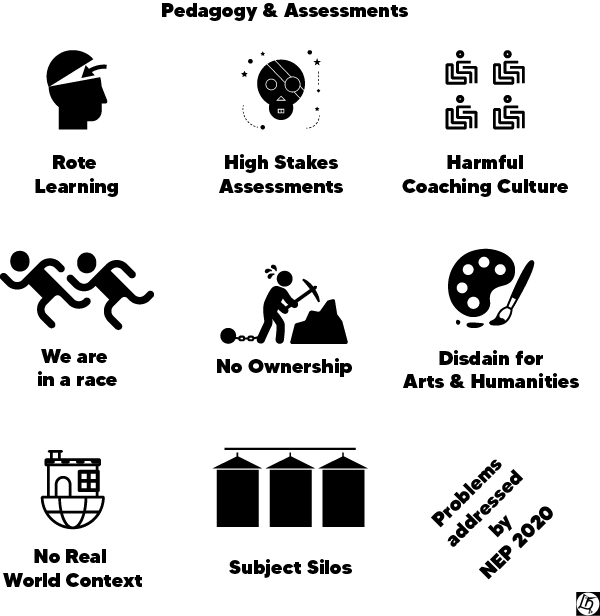
2. Teachers
Without a motivated teacher, there is no inspired student. The NEP acknowledges this and the fact that the current system does not reward, encourage or even aim to enable motivated teachers. The current system leaves teachers with:
- Low social and economic standing. It is one of the least desired professions.
- No autonomy in choosing pedagogy or timelines to inspire their students.
- No training in latest advancements in pedagogy and teaching tools.
- No professional development and growth trajectories.
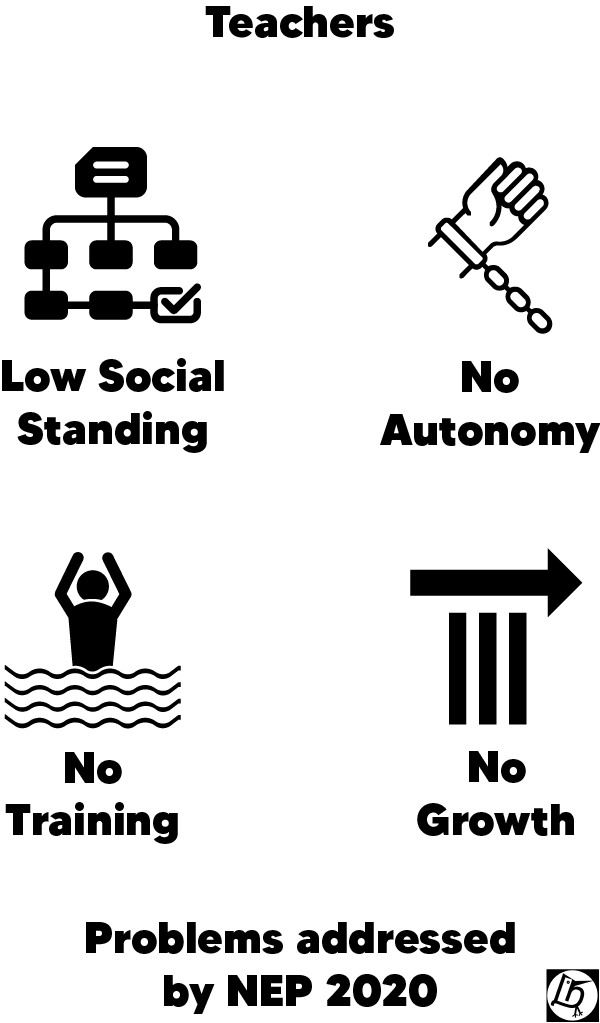
3. Educational institutions
Instead of being pillars of social advancement, educational institutions have become symbols of unreasonable authority, unregulated entitlement, and tools for inequality and oppression. The NEP admits this and comes up with fixes. The current system allows:
- Educational institutions to indulge in profit-mongering at the cost of vulnerable sections of the population: children and uninformed parents.
- Low quality, specialized colleges to spring up like pests
- Monopoly and the resultant stagnation of “prestigious” institutions living in past glory and credits.
- Stifling of progressive institutions with lack of autonomy and empowerment in terms of pedagogical experimentation and research.
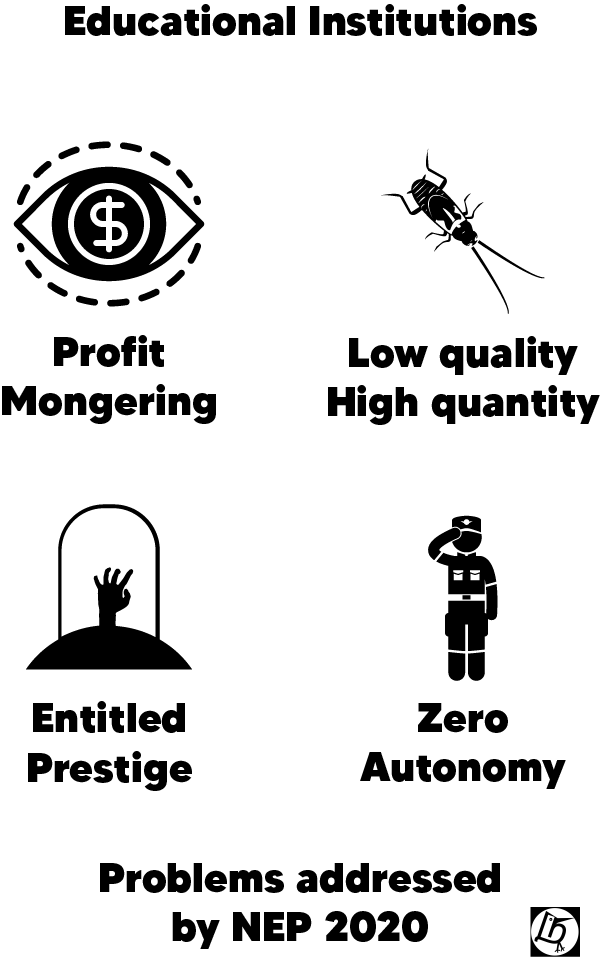
4. Research & Spending
Schools & Universities are where learning happens. Learning without creation is stagnant consumption. Lack of spending and research initiatives stalls progress and creates breeding grounds for bad players. The current situation:
- Results in lack of progress in research and innovation
- Results in poor educational infrastructure
- Encourages predatory companies destroying the future of our children by preying upon their time and their parents money.
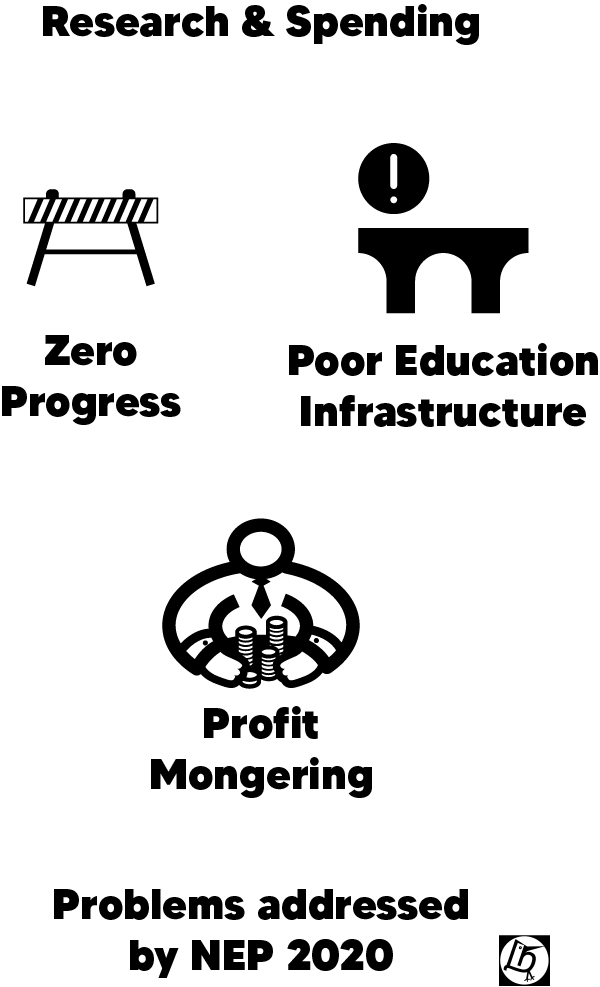
There are some serious issues with it as well
Section 4.17
Sanskrit, while also an important modern language mentioned in the Eighth Schedule of the Constitution of India, possesses a classical literature that is greater in volume than that of Latin and Greek put together
NEP has the right vision and plan for the most part. However, it is not without its problems. I’m extremely concerned about the following:
- Sanskrit is elevated as the lingua-franca without considering historic, cultural and identity conflicts in such a proposition.
- Questionable methods (AYUSH in medicine for example) are given importance without regard for the relative advancement of scientific alternatives.
- In a country with diverse and often conflicting values, the requirement that teachers must espouse “Indian values” is impractical.
- Unacceptably high usage of the word “holistic” :)
- The idea of school clusters and disenfranchisement of small schools creates new power structures and brokers.
Not a pipe-dream
Section 27.3
In the decade of 2030-40, the entire policy will be in an operational mode, following which another comprehensive review will be undertaken
It is honest in its acceptance that true change lies in implementation. It is also reasonable in its timelines and expectations.
Verdict
Introduction: Paragraph 1
India will have the highest population of young people in the world over the next decade, and our ability to provide high-quality educational opportunities to them will determine the future of our country.
The NEP is built on a principled foundation with a clear focus. It is evident that large parts of this was written by well informed, progressive and honest educators. It shows a good understanding of the status quo and offers reasonable solutions based on current research in education.
However, there is some propagandist ideology embedded in the document. It violates the tenet: “Keep religious and political messaging out of education”. I hope that the entire policy document doesn’t come under criticism for this violation.
I will get into the nitty-gritty with excerpts from the document in the following sections. If you do not have a tall glass of caffeine and some snacks, its time to get some :)
The Good Parts: Fixing the most important problems
Introduction: Paragraph 10
Education is a great leveller and is the best tool for achieving economic and social mobility, inclusion and equality.
The NEP has identified problems with the current system and taken a principled approach towards solutions. In this section, I will go through each of the identified problems and NEP’s proposed solutions.
Pedagogy & assessments
Section 4.4
The key overall thrust of curriculum and pedagogy reform across all stages will be to move the education system towards real understanding and towards learning how to learn - and away from the culture of rote learning as is largely present today.
NEP2020 lays the foundation for fixing the curricular, pedagogical and aspirational issues with Indian education by shifting the focus away from rote memorization to true learning. Once again, the language used is precise, detailed and well-researched. Let’s dig in.
Learning to learn: Assessments are feedback
Section 4.5
Curriculum content will be reduced in each subject to its core essentials, to make space for critical thinking and more holistic, inquiry-based, discovery-based, discussion-based, and analysis based learning
The NEP plans to address this problem by reducing the curricular content. Decrease focus on knowledge or “push” and increase focus on experience or “pull”. The learning outcomes move away from memorization towards creation, understanding and experiential assimilation.
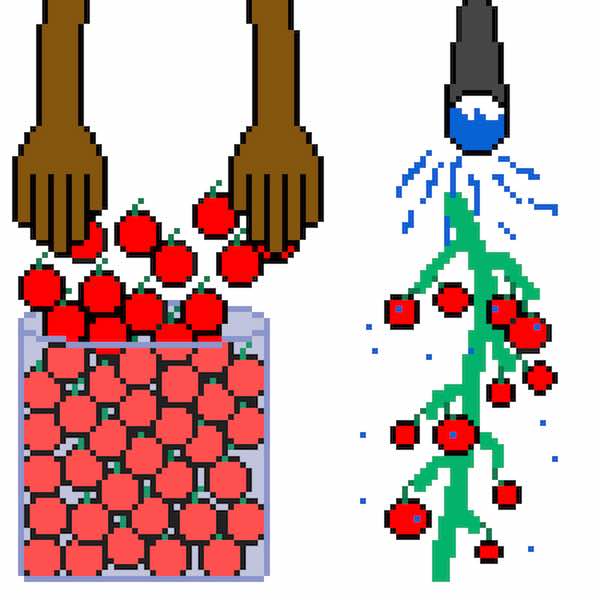
This is a great first step in establishing pedagogy. However, without reforming assessments, this problem cannot be addressed. The NEP takes that into account as well. It calls for a complete change in how assessments are structured and evaluated.
Section 4.5
The mandated content will focus on key concepts, ideas, applications, and problem solving. Teaching and learning will be conducted in a more interactive manner; questions will be encouraged, and classroom sessions will regularly contain more fun, creative, collaborative, and exploratory activities for students for deeper and more experiential learning.
Section 4.37
While the Board exams for Grades 10 and 12 will be continued, the existing system of Board and entrance examinations shall be reformed to eliminate the need for undertaking coaching classes.
The NEP looks at assessment from 3 perspectives:
- assessment as learning: Tools of reflection for the student
- assessment of learning: Tools for the teacher to test their students
- assessment for learning: Tools of reflection for the teachers
Once this distinction is in the guiding principles, it is easy to translate it in implementation. But it doesn’t stop there. It goes further by accepting the “harmful effects” of the current system and the necessity that spending quality time (“basic effort”) in school ought to be sufficient for taking these assessments. It underscores the bold statement with the pragmatic claim “board exams shall be made ‘easy’”.
Section 4.6
The assessment tools (including assessment “as”, “of” and “for” learning) will also be aligned with the learning outcomes, capabilities, and dispositions as specified for each subject of a given class.
Section 4.37
To reverse these harmful effects of the current assessment system, Board exams will be redesigned to encourage holistic development; students will be able to choose many of the subjects in which they take Board exams, depending on their individualized interests. Board exams will also be made ‘easier’, in the sense that they will test primarily core capacities/competencies rather than months of coaching and memorization; any student who has been going to and making a basic effort in a school class will be able to pass and do well in the corresponding subject Board Exam without much additional effort.
What if a student has been having a bad day, week, month or year? Well, not to worry, says NEP. A student is allowed to take the board exams twice in one year. No more “high stakes” and no more coaching classes.
Section 4.37
To further eliminate the ‘high stakes’ aspect of Board Exams, all students will be allowed to take Board Exams on up to two occasions during any given school year, one main examination and one for improvement, if desired.
Section 4.38
In addition to introducing greater flexibility, student choice, and best-of-two attempts, assessments that primarily test core capacities must be the immediate key reforms to all Board exams. Boards may over time also develop further viable models of Board Exams that reduce pressure and the coaching culture
Section 4.34
The primary purpose of assessment will indeed be for learning; it will help the teacher and student, and the entire schooling system, continuously revise teaching-learning processes to optimize learning and development for all students. This will be the underlying principle for assessment at all levels of education.
Section 12.1
The assessment methods must be scientific, designed to continuously improve learning and test the application of knowledge.
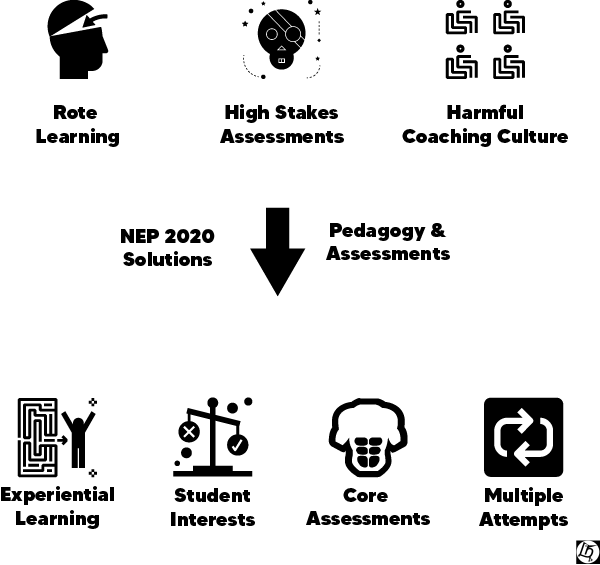
The NEP shows the right amount of urgency here by aiming to get this in motion by the academic year 2022-23.
Section 4.39
teachers prepared, for a transformation in the assessment system by the 2022-23 academic session, to align with the NCFSE 2020-21.
Own your learning: It’s not a race
Section 4.42
Students will be able to choose the subjects for taking the test, and each university will be able to see each student’s individual subject portfolio and admit students into their programmes based on individual interests and talents.
There will no longer be predefined “groups” of subjects to choose from. Students choose the subjects they are interested in and learn. This is the most progressive change of all as this transfers the ownership to the students. Most people in India are familiar with the conversation “Which course / group has value?” - which translates to the amount of jobs available in the market.
With emphasis on “individual interests and talents”, NEP now not only provides ownership of their life and learning to the children but also challenges the risk-averse mindset of the adults. Bravo!
Section 4.2
In particular students would continue to have the option of exiting after Grade 10 and re-entering in the next phase to pursue vocational or any other courses available in Grades 11- 12, including specialized school, at a more if so desired.
Section 11.9
The undergraduate degree will be of either 3 or 4-year duration, with multiple exit options within this period
Section 11.9
An Academic Bank of Credit (ABC) shall be established which would digitally store the academic credits earned from various recognized HEIs so that the degrees from an HEI can be awarded taking into account credits earned
The NEP highlights the ability of students to enter and exit the learning process multiple times. This clearly paves way for thinking about learning as a journey with diverse paths. Not an unforgiving start-to-finish sprint with one final success or failure.
In combination with transferring ownership to students, these policy decisions underscore the fact that learning is a lifelong process and can be paused and continued at convenience perpetually.
Looking at learning as a joyous, willful process instead of a treadmill race makes the system hugely beneficial to learners. This allows children and adults to experiment, explore, knowing that they can always get back to learning. This will hopefully trigger a mindset change to remove any stigma associated with break in academic pursuit.
Section 11.5
Imaginative and flexible curricular structures will enable creative combinations of disciplines for study, and would offer multiple entry and exit points, thus, removing currently prevalent rigid boundaries and creating new possibilities for life-long learning.
Section 12.2
HEIs(Higher Education Institutions) shall also move away from high-stakes examinations towards more continuous and comprehensive evaluation.
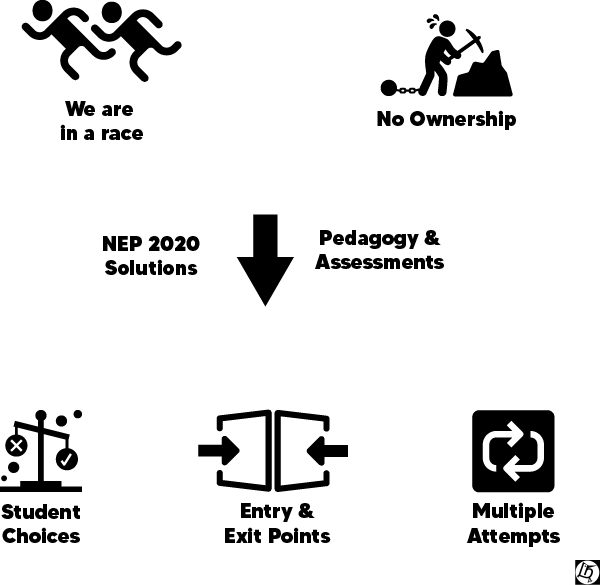
Learn to create: All subjects are related
Section 4.7
Art-integration is a cross-curricular pedagogical approach that utilizes various aspects and forms of art and culture as the basis for learning of concepts across subjects
Section 4.9
There will be no hard separation among ‘curricular’, ‘extracurricular’, or ‘co-curricular’, among ‘arts’, ‘humanities’, and ‘sciences’, or between ‘vocational’ or ‘academic’ streams
NEP delivers the final gut-punch to the vicious cycle of schools + marks = jobs. The NEP admits that unless children are multi-dimensional, look beyond the subject and look into the connections and relationships, they are not preparing themselves for a creative 21st-century life.
It scolds the current system for looking down upon arts, humanities, vocational skills, etc, and placing all the bets on the “job landing” skills instead of “job creating” skills.
Section 16.3
Vocational education is perceived to be inferior to mainstream education and meant largely for students who are unable to cope with the latter. This is a perception that affects the choices students make. It is a serious concern that can only be dealt with by a complete re-imagination of how vocational education is offered to students in the future
Section 11.6
Pedagogy will have an increased emphasis on communication, discussion, debate, research, and opportunities for cross-disciplinary and interdisciplinary thinking.
Once again, with my heart brimming with pride, I acknowledge the competence of the authors when they proclaim how humanities are a great vessel for learning.
It even goes onto mockingly praise “bagless periods” clearly suggesting how harmful it is to view children as dumpsters of knowledge instead of joyful learners from experience.
The NEP, by acknowledging the problems with the current system, has given validation for honest, do-good, progressive educators like us and for that I’m so grateful.
Section 9.2
Some of the major problems currently faced by the higher education system in India include:
…
a rigid separation of disciplines, with early specialisation and streaming of students into narrow areas of study;
Section 4.6
In all stages, experiential learning will be adopted, including hands-on learning, arts-integrated and sports-integrated education, story-telling-based pedagogy, among others, as standard pedagogy within each subject, and with explorations of relations among different subjects.
Section 4.26
All students will participate in a 10-day bagless period sometime during Grades 6-8 where they intern with local vocational experts such as carpenters, gardeners, potters, artists, etc. Similar internship opportunities to learn vocational subjects may be made available to students throughout Grades 6-12, including holiday periods
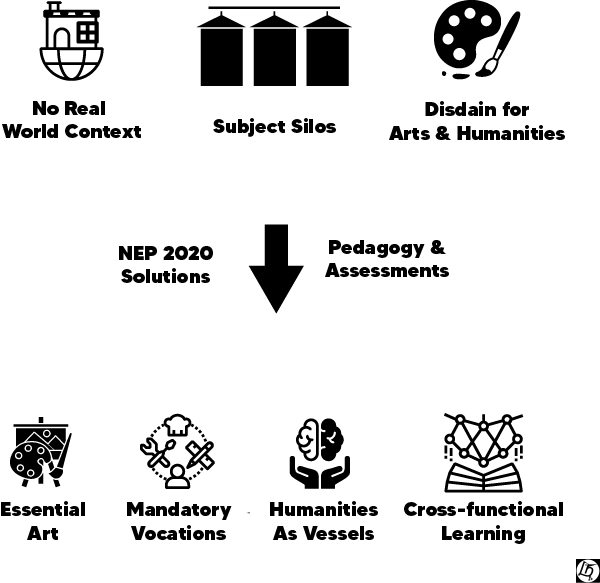
Teachers
Principles of this policy
teachers and faculty as the heart of the learning process – their recruitment, continuous professional development, positive working environments and service conditions;
Not the bottom of the barrel: Teachers are pillars of a society
Section 5.1
Teachers truly shape the future of our children - and, therefore, the future of our nation. It is because of this noblest role that the teacher in India was the most respected member of society. Only the very best and most learned became teachers. Society gave teachers, or gurus, what they needed to pass on their knowledge, skills, and ethics optimally to students.
The NEP puts teachers in their well deserved and rightful pedestals. Mata, Pita, Guru, Deivam says an oft-cited ancient proverb. Most interpretations give “Mata”, Mom, the first place. But given the patriarchal nature of most old civilizations, a fairer interpretation would be that the teacher is second only to God.
One of the more terrible side-effects of industrialization has been the fall in the status of a teacher. “Those that can’t do, teach” is more widely accepted than the interpretations above. The result of reduction in social standing of teachers has meant that even the most passionate educators have a difficult choice when choosing their profession.
Section 5.1
The quality of teacher education, recruitment, deployment, service conditions, and empowerment of teachers is not where it should be, and consequently the quality and motivation of teachers does not reach the desired standards. The high respect for teachers and the high status of the teaching profession must be restored so as to inspire the best to enter the teaching profession. The motivation and empowerment of teachers is required to ensure the best possible future for our children and our nation.
The NEP completely acknowledges this fall in status and accepts the pressing necessity of restoring the teaching profession’s dignity to make a lasting change. Elevating teaching as a creative and essential profession instead of a last choice aspiration is a reform that could change the course of a country.
The evidence that the NEP takes this seriously comes in the form of “reduced non-teaching duties” and “increased management positions” for teachers so that they are adequately represented and can influence progress.
Section 5.11
In collaboration with parents and other key local stakeholders, teachers will also be more involved in the governance of schools/school complexes, including as members of the School Management Committees/School Complex Management Committees
Section 5.12
To prevent the large amounts of time spent currently by teachers on non-teaching activities, teachers will not be engaged any longer in work that is not directly related to teaching.
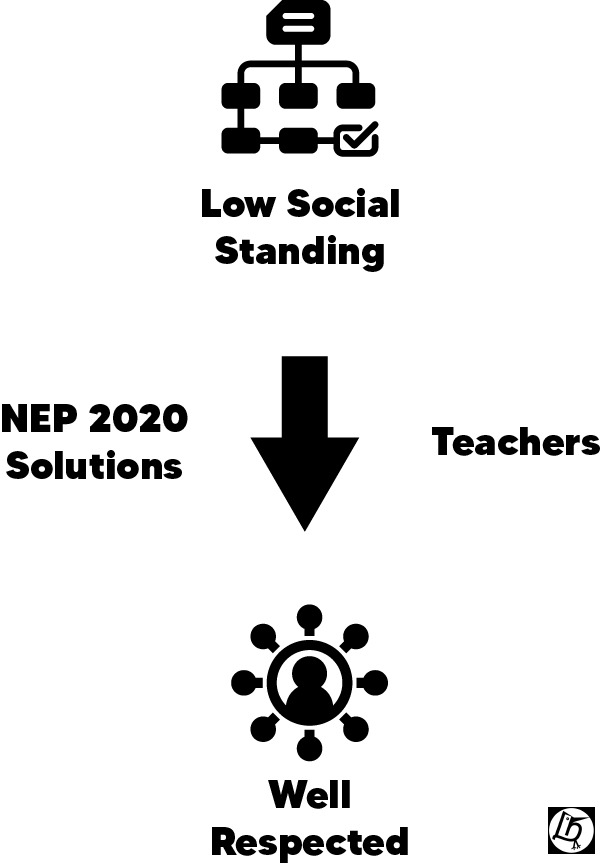
Teacher Empowerment : No glass ceilings
Teaching is a job with extremities. You may be teaching the same thing for 20 years, yet every class is different and every student is unique. You have to change your methods, adapt them to better suit your class.
Section 5.14
Teachers will be given more autonomy in choosing aspects of pedagogy, so that they may teach in the manner they find most effective for the students in their classrooms.
Section 5.14
Teachers will be recognized for novel approaches to teaching that improve learning outcomes in their classrooms
Section 5.17
Teachers doing outstanding work must be recognized and promoted, and given salary raises, to incentivize all teachers to do their best work. Therefore, a robust merit-based structure of tenure, promotion, and salary structure will be developed, with multiple levels within each teacher stage, that incentivizes and recognizes outstanding teachers.
When there is no autonomy, even the most passionate teacher gets disillusioned by the day and ends up being an uninspiring drone. The NEP recognizes this aspect of the profession and duly addresses it. It promises autonomy in choosing the pedagogy. In combination with the reduced curricular content, this empowers teachers to be more effective, to connect with their students and inspire them.
It doesn’t stop there but proposes incentives for teachers that use this autonomy to innovate. What about the teachers that are institutionalized in the old ways? We’ll train them, says the NEP. A mandatory 50 hours of training to keep them abreast of advancements in their field.
Section 5.15
Each teacher will be expected to participate in at least 50 hours of CPD(Continuous professional development) opportunities every year for their own professional development, driven by their own interests. CPD opportunities will, in particular, systematically cover the latest pedagogies regarding foundational literacy and numeracy, formative and adaptive assessment of learning outcomes, competency-based learning, and related pedagogies, such as experiential learning, arts-integrated, sports-integrated, and storytelling-based approaches, etc.
What about economics? What about career growth? The NEP has answers for that as well. It recognizes that there is no class hierarchy in teaching kindergarten versus college students. It recognizes that in each specialized age-group there needs to be career growth. Teachers do not have to graduate to teaching higher classes to earn more.
Section 5.18
Further, it will be ensured that career growth (in terms of tenure, promotions, salary increases, etc.) is available to teachers within a single school stage (i.e., Foundational, Preparatory, Middle, or Secondary), and that there is no career progression-related incentive to move from being teachers in early stages to later stages or vice versa (though such career moves across stages will be allowed, provided the teacher has the desire and qualifications for such a move). This is to support the fact that all stages of school education will require the highest-quality teachers, and no stage will be considered more important than any other.
Section 15.5
Beyond the teaching of cutting-edge pedagogy, the teacher education will include grounding in sociology, history, science, psychology, early childhood care and education, foundational literacy and numeracy,
Section 5.19
Vertical mobility of teachers based on merit will also be paramount; outstanding teachers with demonstrated leadership and management skills would be trained over time to take on academic leadership positions in schools, school complexes, BRCs, CRCs, BITEs, DIETs as well as relevant government departments
With comprehensive understanding of the teacher issues related to motivation, training, performance and autonomy, the NEP meticulously empowers teachers to be their most effective selves.
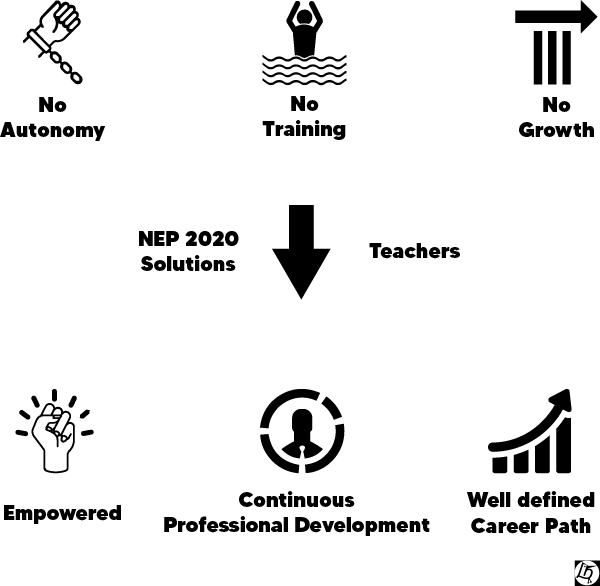
Educational Institutions
Section 8.3
The current regulatory regime also has not been able to curb the commercialization and economic exploitation of parents by many for-profit private schools, yet at the same time it has all too often inadvertently discouraged public-spirited private/philanthropic schools.
In education, there are only a few light bearers left. Most educational institutions are money spinners, many are funded and run by corporate, political or religious entities with hidden agendas. Some funded “tech” ventures are outright scams luring unsuspecting parents into enrolling their kids through predatory sales funnels and blackmailing using parental guilt or greed.
There are a precious few who try to move things forward, keep the interests of students above everything and understand the unquestionable importance of their work. But these institutions have been suffocated by regulations and boards that take away their much needed autonomy to bring about true change.
Does the NEP address these issues?
Education is public service: Rampant commercialization is predatory
Section 18.10
Strict compliance measures with stringent action, including penalties for false disclosure of mandated information, will be ensured so that Higher Education Institutions are conforming to the basic minimum norms and standards
Section 18.12
All education institutions will be held to similar standards of audit and disclosure as a ‘not for profit’ entity. Surpluses, if any, will be reinvested in the educational sector.
…
The accreditation system developed by NAC will provide a complementary check on this system, and NHERC will consider this as one of the key dimensions of its regulatory objective.
Section 8.7
Private philanthropic efforts for quality education will be encouraged - thereby affirming the public-good nature of education - while protecting parents and communities from arbitrary increases in tuition fees
The NEP immediately recognizes how the current policies and regulations have failed to stop predatory behavior from private educational institutions. It mandates that all educational institutions be treated on par with non-profit organizations.
It also emphasizes that the fees and incidentals be laid out transparently on the websites and other public communication platforms.
There is even a complete section (18.12 - 18.14) dedicated to “Curbing Commercialization of Education”. The NEP takes a balanced stand so that “Making a living out of education” is encouraged but “Making living a hell for parents and children through rampant commercialization” is discouraged.
Section 18.14
Private HEIs having a philanthropic and public-spirited intent will be encouraged through a progressive regime of fees determination. Transparent mechanisms for fixing of fees with an upper limit, for different types of institutions depending on their accreditation, will be developed so that individual institutions are not adversely affected.
Commercialization and profiteering from education is a huge problem. The good news is, the NEP acknowledges it and suggests some measures to curb it.
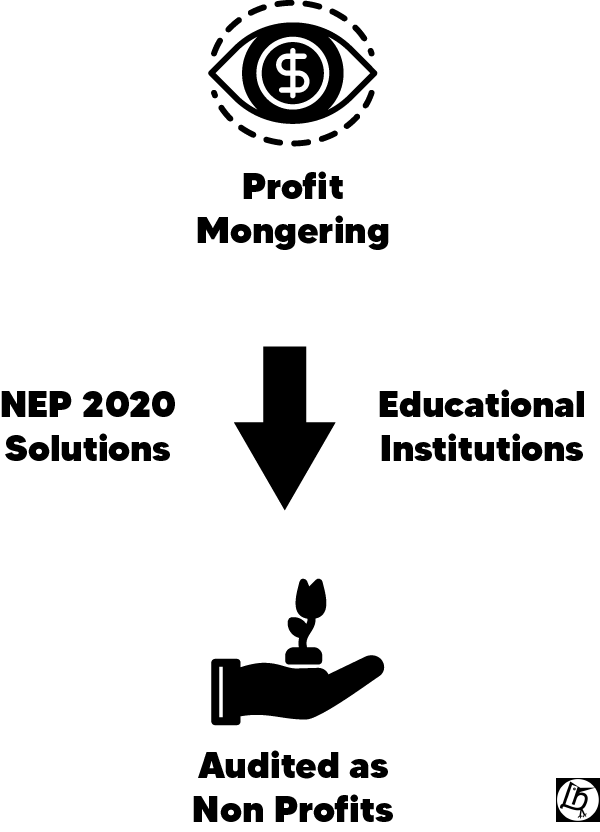
Education needs accountability: Mediocrity is unacceptable
Section 10.11
Single-stream HEIs will be phased out over time, and all will move towards becoming vibrant multidisciplinary institutions or parts of vibrant multidisciplinary HEI clusters, in order to enable and encourage high-quality multidisciplinary and cross-disciplinary teaching and research across fields.
Section 10.14
University, worldwide, means a multidisciplinary institution of higher learning that offers undergraduate, graduate, and Ph.D programmes, and engages in high-quality teaching and research. The present complex nomenclature of HEIs in the country such as ‘deemed to be university’, ‘affiliating university’, ‘affiliating technical university’, ‘unitary university’ shall be replaced simply by ‘university’ on fulfilling the criteria as per norms.
Section 10.4
Over a period of time, it is envisaged that every college would develop into either an Autonomous degree-granting College, or a constituent college of a university - in the latter case, it would be fully a part of the university. With appropriate accreditations, Autonomous degree-granting Colleges could evolve into Research-intensive or Teaching-intensive Universities, if they so aspire.
The NEP goes back to the first principles of what it means to be a university. The various qualified uses of “university” are no longer possible. There is a singular definition of what it means to be an university. Well, there always has been. The NEP now acknowledges the fact.
The infestation of low quality “Engineering” colleges is also highlighted by the requirement that a college needs to be a part of multidisciplinary entity. The NEP brings IITs into the fold as well by requiring them to transform into multidisciplinary entities.
By allowing foreign universities (in the top 100) to setup campuses in India, the NEP challenges IITs & IIMs to raise their standards and innovate. It is no longer possible to stagnate by resting on past laurels and entitled glory.
The elevation of arts, humanities and vocational education will also help in reducing the unreasonable and unsustainable demand for specialized engineering education.
Section 11.4
Even engineering institutions, such as IITs, will move towards more holistic and multidisciplinary education with more arts and humanities.
Section 12.8
High performing Indian universities will be encouraged to set up campuses in other countries, and similarly, selected universities e.g., those from among the top 100 universities in the world will be facilitated to operate in India
The NEP has comprehensive plans and guidelines to increase the quality of higher education.
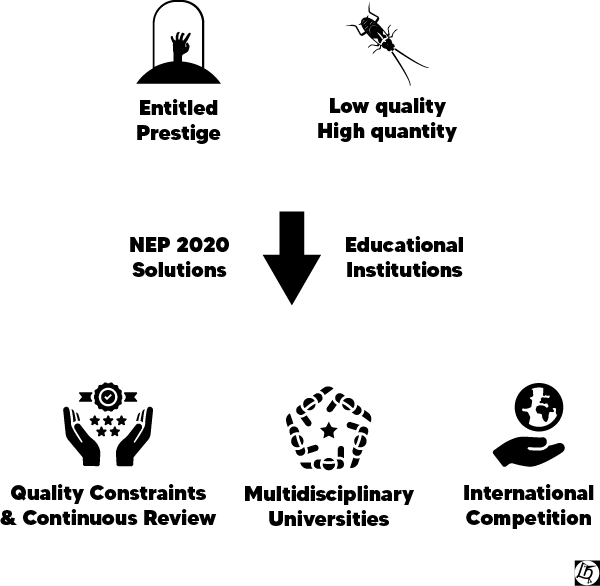
Education needs improvement: The world does not stand still
Section 23.10
HEIs will play an active role not only in conducting research on disruptive technologies but also in creating initial versions of instructional materials and courses including online courses in cutting-edge domains and assessing their impact on specific areas such as professional education.
Section 7.8
The school complex/cluster will be given significant autonomy by the DSE to innovate towards providing integrated education and to experiment with pedagogies, curriculum, etc., while adhering to the National Curricular Framework (NCF) and State Curricular Framework (SCF). Under this organization, schools will gain in strength, will be able to exercise greater freedom, and will contribute towards making the complex more innovative and responsive. Meanwhile, the DSE will be able to focus on the aggregate level goals that need to be achieved, improving overall system effectiveness
The NEP, with immense clarity, acknowledges the need to provide autonomy to schools to innovate while at the same time having some kind of central guidelines to ensure that the innovations are not regressive.
Section 7.10
To further enhance cooperation and positive synergy among schools, including between public and private schools, the twinning/pairing of one public school with one private school will be adopted across the country, so that such paired schools may meet/interact with each other, learn from each other, and also share resources, if possible. Best practices of private schools will be documented, shared, and institutionalized in public schools, and vice versa, where possible
The depth of thought in the policy is astounding here as it also recognizes the need for these innovations to percolate across institutions. The pairing of public and private schools is a wonderful idea and I wish and hope it is one of the first things to be implemented by the new Ministry of Education.
The NEP goes above and beyond solving the problem by laying out guidelines for continuous improvement.
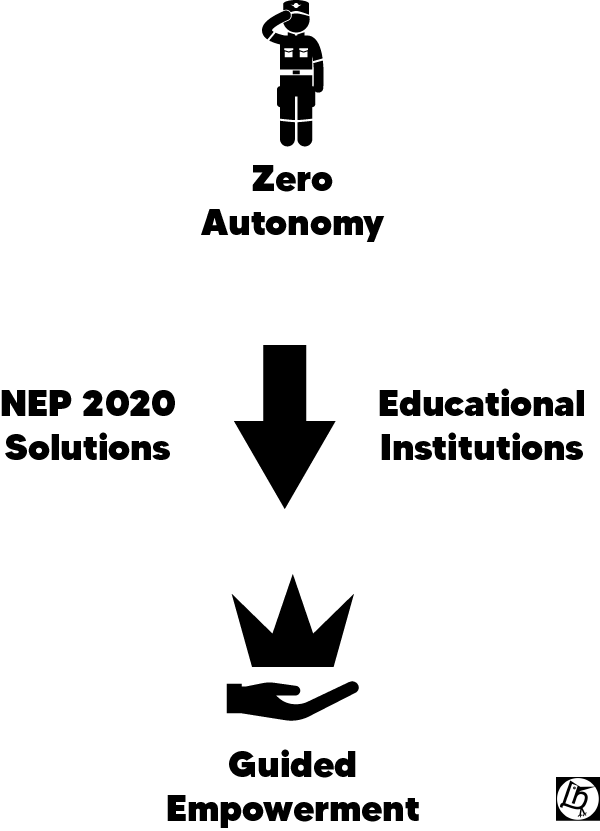
Research & Spending
Section 17.3
Despite this critical importance of research, the research and innovation investment in India is, at the current time, only 0.69% of GDP as compared to 2.8% in the United States of America, 4.3% in Israel and 4.2% in South Korea.
Most cutting edge innovations in the last 100 years from the Internet, to Google to Artificial Intelligence to Programming Languages have their roots in university research. What percentage of those innovations are from universities in India? The numbers are decidedly shame-worthy. Does the NEP address this as a concern?
Learning is creation: No research, no progress
Section 17.5
Research in the arts and humanities, along with innovations in the sciences and social sciences, are, therefore, extremely important for the progress and enlightened nature of a nation
Section 17.9
To build on these various elements in a synergistic manner, and to thereby truly grow and catalyze quality research in the nation, this policy envisions the establishment of a National Research Foundation (NRF).
The NEP admits to the current lack of focus on research and emphasizes the need to invest, nurture and enable educational institutions as knowledge factories. To bolster that effort, it envisions a new entity NRF (National Research Foundation) whose sole purpose is to set up and advance research in educational institutions. The NEP brings up “Knowledge Creation” to refer to research efforts giving it a creative emphasis instead of the usual, dry, mechanical perspective offered.
This is a major shift in perspective from the current situation. The NEP furthers the cause by stating that “a strong culture of research” implies a strong culture of learning. If this stance is solidified, institutions with better research will become more coveted by the students establishing a wonderful virtuous cycle.
Section 17.6
Research and innovation at education institutions in India, particularly those that are engaged in higher education, is critical. Evidence from the world’s best universities throughout history shows that the best teaching and learning processes at the higher education level occur in environments where there is also a strong culture of research and knowledge creation; conversely, much of the very best research in the world has occurred in multidisciplinary university settings.
Invest in Research: Knowledge creation will pay for itself
While there are multiple organizations that fund research, the funding is minuscule compared to the rest of the world. Without adequate funding, most research projects are curtailed in their ambitions and runway, and are forced to resort to mediocre findings or worse, plagiarism.
Section 17.11
The primary activities of the NRF will be to:
fund competitive, peer-reviewed grant proposals of all types and across all disciplines;
seed, grow, and facilitate research at academic institutions, particularly at universities and colleges where research is currently in a nascent stage, through mentoring of such institutions;
act as a liaison between researchers and relevant branches of government as well as industry, so that research scholars are constantly made aware of the most urgent national research issues, and so that policymakers are constantly made aware of the latest breakthroughs; so as to optimally allow breakthroughs to be brought into policy and/or implementation; and
recognise outstanding research and progress
Section 26.2
The Centre and the States will work together to increase the public investment in Education sector to reach 6% of GDP at the earliest. This is considered extremely critical for achieving the high-quality and equitable public education system that is truly needed for India’s future economic, social, cultural, intellectual, and technological progress and growth.
The NEP ordains the NRF with the primary responsibility of funding worthy research projects. It further instructs the NRF to act as a mentor to ensure the success of such projects and be the conduit for relationship with industry.
The establishment of NRF and its responsibilities definitely move the needle forward in terms of establishing research wings in universities.

The Mediocre Parts: What could’ve been better?
The NEP 2020 is probably one of the most radically progressive policy documents to be published by the Indian government. There are few parts where the policy avoids greatness and embraces mediocrity.
Assessments: So close, yet so far
Section 4.38
Some possibilities include: a system of annual/semester/modular Board Exams could be developed - that each test far less material, and are taken immediately after the corresponding course is taken in school - so that the pressure from exams is better distributed, less intense, and less high-stakes across the Secondary Stage
It is never okay to blame a child to not meet the standards set by adults. The fault is always with the grown up. The NEP comes very close to saying that. However, it stops short of it and says the student is allowed to attempt one more time to “improve” their scores.
Why did the student not get a good score the first time? Is the student to be blamed? What are the living conditions of the student? Are there any learning difficulties faced by them? Are there other personal, social or emotional issues that are deterring them from being their best? How can the policy help?
I wish these questions were asked and answered.
Teachers: More should be done
Section 5.12 - Review/Circulation version
teachers will not be involved in electioneering, cooking of midday meals, and other strenuous administrative tasks, so that they may fully concentrate on their teaching-learning duties.
Section 5.12 - Final version
teachers will not be involved in strenuous administrative tasks and more than a rationalized minimum time for mid-day meal related work,
An earlier version of the NEP proclaimed that teachers shall no longer be required to perform electioneering. The final version, however, has removed that statement. I hope it is removed to make sure there is sufficient time to find alternatives. Because, as the document says, teaching requires a lot of time, energy (emotional, physical and mental) and effort and teachers should not be distracted with anything else.
Section 13.6
A system of multiple parameters for proper performance assessment, for the purposes of ‘tenure’ i.e., confirmed employment after probation, promotion, salary increases, recognitions, etc., including peer and student reviews, innovations in teaching and pedagogy, quality and impact of research, professional development activities, and other forms of service to the institution and the community, shall be developed by each HEI and clearly enunciated in it ’s Institutional Development Plan (IDP).
Teaching is one of the top professions in Finland and many of the educationally progressive countries. The NEP talks highly about the profession and promises salary increases and career development. But will it make teaching a coveted profession? No such promise has been made.
IITs and IIMs: No call to action
Section 11.11
Model public universities for holistic and multidisciplinary education, at par with IITs, IIMs, etc., called MERUs (Multidisciplinary Education and Research Universities) will be set up and will aim to attain the highest global standards in quality education. They will also help set the highest standards for multidisciplinary education across India.
With the wonderful privileges granted to these institutions, why have they not created revolutionary, industry defining work products? These institutions have been operating with impunity and privilege all these years and they should have been explicitly called out for their ineptitude. If they are not called out, how can the new MERUs be held accountable for their quality of effort?
Research oriented & Learning oriented universities
Section 10.3
The definition of university will thus allow a spectrum of institutions that range from those that place equal emphasis on teaching and research i.e., Research-intensive Universities, those that place greater emphasis on teaching but still conduct significant research i.e. Teaching-intensive Universities.
The NEP proclaims with authority that universities with excellent research thrive as better learning environments. Given that assertion, why allow learning / teaching oriented universities? Why can’t all universities have brilliant research wings?
EdTech Companies: No promise to stop predatory behavior
Section 10.10
Top institutions accredited for ODL will be encouraged and supported to develop high-quality online courses. Such quality online courses will be suitably integrated into curricula of HEIs, and blended mode will be preferred.
There is no regulation on corporate entities profiting with schemes and deals that prey on parental insecurity and guilt. This impacts children, the most vulnerable section of a society. While the policy document is critical of coaching culture and proclaims that it will cease to exist, it doesn’t promise any regulations on predatory entities.
With the overwhelming support for online courses in educational institutions, these entities will gain more credibility and standing and without regulatory supervision, may destroy all the good things this policy aims for.
The Concerning Parts: Things to be careful about
Education shapes the minds of people. Education can make the population thrive or suffer. In a diverse, large, dense country like India, a radical change in national policy is no small thing. The citizenry should be literate of the changes, praise the good, and question the bad.
Like natural resources and the environment, an education policy can leave its mark on multiple generations.
Education in Indian Languages
Section 4.11
Wherever possible, the medium of instruction until at least Grade 5, but preferably till Grade 8 and beyond, will be the home language/mother tongue/local language/regional language. Thereafter, the home/local language shall continue to be taught as a language wherever possible. This will be followed by both public and private schools. High-quality textbooks, including in science, will be made available in home languages/mother tongue.
Early childhood education happening in local languages is a fantastic leveler. It reduces the chasm between children from either side of the great Indian economic divide.
However, the NEP, while mandating education in the local language, does not get into how it will ascertain the distribution of resources among the myriad of languages in India or how standards will be maintained across these languages.
Will the educational material be created in one language (any guesses?) and others will be mediocre translations? Will it depend on the states to make their language material on par with other languages? Will funds be allocated in proportion to population or equally? What about state level minority languages?
Suddenly, there is a new educational meridian: A linguistic line of division. Who will make sure that this line of division doesn’t bifurcate the population into another class system of haves and have-nots?
Elevation of Sanskrit
Section 4.17
Sanskrit will thus be offered at all levels of school and higher education as an important, enriching option for students, including as option in the three-language formula. It will be taught in ways that are interesting and experiential as well as contemporarily relevant, including through the use of Sanskrit Knowledge Systems, and in particular through phonetics and pronunciation. Sanskrit textbooks at the foundational and middle school level may be written in Simple Standard Sanskrit (SSS) to teach Sanskrit through Sanskrit (STS) and make its study truly enjoyable.
Most old civilizations have dark histories. History of oppression, cruelty, slavery, genocide or even cannibalism. India is not an exception. For some, it is the good old days. For others, it is the horrors of the past.
Sanskrit is a language of the past. It is not spoken in common. Not for centuries. It brings with it the past and the events associated with that time. Even in its prime, it was the language of the elites, the oppressors. So, bringing back Sanskrit begs the question, are we bringing back those days, the days of the oppressors and the oppressed? Are we granting the moral sanction to our society that some people are more equal than the others? Aren’t we past all that?
Some may ask, isn’t English the language of a more recent oppressor? Yes, it is. But the oppressors are not around anymore, are they? The people that used Sanskrit as a tool for their oppression, though, are still around. They are in the philosophies handed down to their descendants. They are in the prejudices carried forward socially. These prejudices, so far, have had no legal or political sanction. Question is, are we accepting those prejudices now?
Some may say, isn’t it necessary for children to learn the rich literature of ancient India? The rich literature of ancient India includes volumes of epics in other languages as well. So, what makes Sanskrit special? Why is the NEP elevating its status as the language that defines India or Indian-ness?
Some Dravidian languages claim to be as old as Sanskrit and are in active use today with words from ancient poetry finding their way into movie songs. For many Indians, their language is part of their identity, their pride, their strength - their roar when they fought oppression, their prayer when they sang in devotion, their affection when they composed their creations. Why alienate their sense of pride, emotion and identity? Linguistic pluralism is as important an aspect of being Indian as any other. Why does the NEP ignore this?
So, what does the special status offered to Sanskrit in a National Education Policy mean to India? A populace that could easily be divided in a million ways? I’m very concerned. You should be too.
Elevation of AYUSH
Section 20.5
Given that people exercise pluralistic choices in healthcare, our healthcare education system must be integrative meaning thereby that all students of allopathic medical education must have a basic understanding of Ayurveda, Yoga and Naturopathy, Unani, Siddha, and Homeopathy (AYUSH), and vice versa.
Modern medicine powered by scientific method has helped increase the average life-span of a human being to almost a century. Every old civilization, historically, has its own medicine and medicine men/women. Some of those treatments are miraculous and under-explored.
Exploring any form of knowledge must be appreciated and encouraged. So active research in traditional Indian medicine (Ayurveda, Unani & Siddha), physical exercises (Yoga) are to be carried out in research institutions. Scientific method must be applied to these age old treatments to gather sufficient evidence before it is accepted and sold in pharmacies.
However, taking the old medical practices at face value, without employing the scientific method is not sensible. The policy cannot on the one hand talk about “scientific temper” and on the other encourage teaching old practices without applying the same rigor.
The “H” in AYUSH is another concerning element. There is sufficient literature debunking the credibility of homeopathy as a medical practice. It is not even traditional Indian medicine. It seems to garner support in the policy document only as an alternative approach to “scientific temper”.
New power brokers
Section 5.10
The creation of school complexes could go a long way towards building vibrant teacher communities. The hiring of teachers to school complexes could automatically create relationships among schools across the school complex; it would also help ensure excellent subject-wise distribution of teachers, creating a more vibrant teacher knowledge base. Teachers at very small schools will not remain isolated any longer and may become part of and work with larger school complex communities, sharing best practices with each other and working collaboratively to ensure that all children are learning. School complexes could also share counsellors, trained social workers, technical and maintenance staff, etc. to further support teachers and help create an effective learning environment.
Section 10.2
Moving to large multidisciplinary universities and HEI clusters is thus the highest recommendation of this policy regarding the structure of higher education.
The introduction of “school complexes” and “Multi-disciplinary university clusters” brings into effect more power brokers. Who heads the complexes? Who heads these clusters? How can we make sure the small fish is not consumed by the big fish?
Historically, education has been propelled in smaller settings. Pedagogical innovation happens at a small scale and then gets propagated. How will the ministry help the small fish assert themselves? How will their autonomy be protected? How can they derive a reasonable and deserving benefit from their innovations?
Holistic :)
Section 11: Towards a More Holistic and Multidisciplinary Education
11.1. India has a long tradition of holistic and multidisciplinary learning,
…
11.2.
…
Research is also improved and enhanced through a holistic and multidisciplinary education approach.
…
11.3. A holistic and multidisciplinary education would aim to develop all capacities of human beings
…
Such a holistic education shall be, in the long term, the approach of all undergraduate programmes, including those in professional, technical, and vocational disciplines.
…
11.4. A holistic and multidisciplinary education, as described so beautifully in India ’s past, is indeed what is needed for the education of India
…
Even engineering institutions, such as IITs, will move towards more holistic and multidisciplinary education with more arts and humanities. Students of arts and humanities will aim to learn more science and all will make an effort to incorporate more vocational subjects and soft skills.
…
There are 34 uses of the word “holistic” in the document. Precise words like “multidisciplinary”, “cross functional”, and “experiential learning” are used in other parts of the document. I wish the authors had used more contextually meaningful and descriptive words instead, lending more credibility to the otherwise holistic content in the document.
What does it mean to me?
This is a radical policy change after 34 years. The policy document is extremely critical of the status-quo to the point where it uses words like “harmful”, “ineffective”, “crisis”, etc.,
It proposes radical changes to pedagogy, teaching, school structure, and higher education at a foundational level. It goes onto say that a complete implementation of the guidelines in the policy will be done by the year 2030. Some of the proposed changes have an ambitious deadline: 2022. So, no matter who you are, you will feel the impact of this policy.
I’m a Student
Your government just told that the current system of education is ineffective and the assessments could be harmful. Rote learning is insufficient and experiential learning with complete understanding is essential.
Here are a few things to think about:
- Change your approach to learning. Ask more questions. Don’t stop until you understand.
- It is better to understand one thing really well than memorize 10 things and not understand them at all.
- Your marks don’t define you. They are simply a few metrics to get what you want. You have all the time in the world. The most important thing is to enjoy your learning.
- You are not in a race. Find pleasure in learning new things.
- There are more fields than engineering and medicine. Arts and humanities are important.
- Learn more about your country, its people, their languages and culture.
- Be a good citizen. Understand the current affairs. Be aware of how the world is operating around you. Try to figure out your place in this world - it is a life-long process - better to start early.
I’m a Parent
Give your children the freedom of choice. Don’t guilt them with their performance in examination. Ensure that they enjoy learning. Encourage them to question and understand. They will have to compete with better prepared youngsters produced by an improved education system; it is up to you to ensure that your children are well rounded.
Read the above section. Then read the section on parents in my previous article. You can do exactly what is said in that article, but now you can do it with authority. Your government stands with you. Use the NEP as your guide and enforcer.
I’m a Teacher
Read the NEP from start to finish. Get acquainted with pedagogical improvements across the world. Ask yourself these questions:
- What is the best way for my students to learn this without me teaching it? Can they experience / discover it somehow?
- How can I make my students enjoy what I’m supposed to teach? Am I inspiring them?
- Are there any games that can make the learning joyful? Can I create them?
- Are my students asking enough questions? How can I make them ask more questions?
- Are my students debating among themselves?
- Who is talking more? Me or my students?
- Can my students apply what they just learned?
- How can I help my students see relationships, connections and patterns among the things they learn?
- Are there real world examples that I can use as a guideline to inspire my students?
I’m a School
You need to change. Now! Hire teachers that can inspire your students. Pay them well. Ensure you have teachers who are multi-talented. Ensure that there are inspiring art, music and sports activities in your curriculum and teachers that are passionate creators and performers.
Stop blaming your students and start helping them. When a student is “non-performing”, it is your fault. Not theirs. What can you do to help? Where did you fail?
Read suggestions from my previous article.
I’m an after school academic tutor
The NEP clearly calls after school coaching centers as harmful. Find something else to do. Children’s time is precious. It is unacceptable for children to do the same thing at school and after school.
Read the NEP. Become a teacher - an exceptional one. Start a school. Anything but a tuition center.
I’m an EdTech Startup offering academic support
If the slow, under-the-breath chastising of your predatory behavior has not reached your ears, the NEP scolds you in loudest terms. “Harmful coaching culture”, it says. You are the prime perpetrator. You are not the attentive personal academic tutor above, but you are the lustful predator that lures guilty, insecure parents into your trap.
Shutdown, retire and do something good for the society, for a change.
I’m the Ministry of Education
Kudos. I bow my head to the most wonderful thing I’ve read in Indian education. As an educator and education reformer, this document has validated my work, effort and words. Thank you.
Please pay attention to the concerns highlighted in this article. They may be political requirements. If so, please move them to an addendum so that the credibility of the rest of this incredible document is not questioned.
Summary
There are many more wonderful things like special education, adult and life-long learning, nutrition, etc that are covered in the NEP. They are to be read and relished.
As an Indian citizen, as an educator, as a parent the NEP has filled me with hope. It has given me fuel to continue my work. It has given my words recognition and validation. It has given me an authority to appeal to. For that I’m immensely thankful.
There are some propagandist ideologies and scientific missteps highlighted in the article that I’m deeply concerned about. That said, I am surprised, thankful and excited about this progressive, scientific, visionary policy.
The future of Indian education shines bright.
If you are in education as one of the stakeholders and want to continue this conversation with me, feel free to reach out on any of the social media platforms linked below or email me (navilan at puthir dot in). You can learn about our progressive work in education on the Puthir website.
